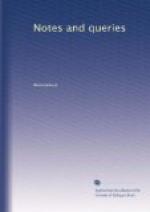J.W.H. {199}
Aerostation, Works on.—Will you have the goodness to inquire for me among your readers and contributors, for the titles of any works on—or references to good articles in encyclopaedias or dictionaries on—or for remarkable isolated passages relating to—Aerostation, or the arts of, or attempts at, flying, either by means of mechanical wings, &c., or by the aid of balloons.
C.B.M.
Pilgrims’ Road to Canterbury.—Can any of the readers of “Notes and Queries” point out the route which was pursued by Chaucer and his fellow-travellers on the pilgrimage which his genius has immortalised? Is the route of the old pilgrims’ road laid down upon any early maps? (it is not, I believe, marked on the Ordnance Survey;) and would it be possible to traverse it at the present time? Any hints upon these points, and any references to objects of interest on the line of road inquired after, will be thankfully received by
Philo-Chaucer.
“AEdricus qui signa fundebat.”—In a chronicle of Battel Abbey, compiled in the twelfth century, there is a list of the abbey’s tenants in the town of Battel. Among many such names as Gilbertus Textor, Godwinus Cocus, Rotbertus filius Siflet, Rotbertus de Havena, I find that of “AEdricus qui signa fundebat.” As this phrase is susceptible of several widely different renderings, I shall be grateful to any of your ingenious readers who will give me their opinions as to its actual meaning. I may add that AEdric was living about the year 1170, so that the phrase can have no reference to events connected with the battle of Hastings.
M.A. Lower.
Lewes, July 30. 1850.
Osmund the Waterman.—In his description of the Flowering Fern (Osmunda regalis), Mr. Newman observes, that “the rhizoma [root-stock], when cut through, has a whitish centre or core, called by old Gerarde in his Herbal, ‘the heart of Osmund the waterman.’ My lore is insufficient to furnish my readers with the history of the said Osmund.” (History of British Ferns, by Ed. Newman, 2nd ed., p. 334.) Can any of your readers supply this deficiency?
J.M.B.
Logic.—What is the earliest printed book on logic? meaning the first which gives the common theory of the syllogism. Does it contain the celebrated words Barbara, Celarent, &c. The difficulty will probably arise from this, that each book has some undated editions which are probably earlier than the dated ones. Of books with dates there is the exposition of Petrus Hispanus by Joh. Versor, in 1473, and the Summulae of Paulus Venetus, in 1474; the first I find in Hain (who had not seen it), the second I have seen. Can any one of your readers go farther back?
M.
Darvon Gatherall?—Can any reader adduce further information respecting an image, called Darvon Gatherall, brought from Wales at the Reformation, than what is mentioned in one of the treatises published by the Camden Society?




